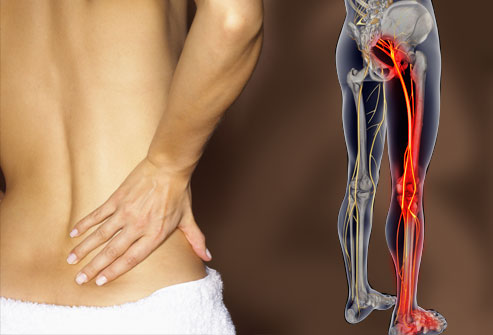Sciatica can be an extremely frustrating symptom. It hurts to sit for any period of time while walking and exercising eventually leave you in pain as well. Sometimes it seems that no matter what you do the pain always follows. Well, what may seem like a death sentence from your doctor ,what he isn’t going to tell you is that there is hope and other options other than surgery, shots and nerve blockers. After reading this article, you will know exactly what Sciatica is, how to diagnose it and how to treat it yourself. That sounds better than getting your foot cut off right?
That’s right, I read that a patient was having such severe sciatic pain into their foot the doctor suggested to amputate. After getting a second and third opinion and working with someone who believes and practices natural healing techniques talked about in this article the pain begin to decrease and continued to decrease as they utilized what they learned. Thank God for second opinions!
On that note, lets get you some sciatica relief!
What is Sciatica?
Sciatica is basically pain experienced anywhere along the entire sciatic nerve. The sciatic nerve runs from the lowest two lumbar joints, through your butt and behind the hip joint. It then travels down the back of the thigh around the front of the shin and ends in the foot and toes.
When it comes to sciatica, since there are so many possible causes it’s best to seek a specialized physician who can help you pin point specific pain triggers and help build a hypothesis on what exactly is going on.
Most sciatica patients will experience one or more of the following obvious symptoms.

Common symptoms to sciatica
- Pain in the butt or leg that gets worse when sitting.
- Weakness or numbness and difficulty moving the affected leg or foot.
- Pain will be either on the right or left side of the lower body.
- Usually pain decreases after walking or laying down.
- Pain is described as either sharp or searing. Sciatica pain would not be described as a “dull” pain.
If you take away anything from this article I want it to be 3 key things that you must always remember when it comes to treating sciatica.
1. When it comes to treating sciatica remove the cause don’t just treat the symptom. An example of this would be to take prescription drugs to “dull” or “manage” the pain. Nerve blockers are also a common symptom treatment that solves nothing. The patient is still left with the same problem just unaware that it’s still going on until it’s so severe they can barely walk.
2. Stretching your hamstrings is NOT the solution to your sciatica. Tight hamstrings is one of the most commonly thrown around “at home” sciatica treatment. Stretching the hamstrings can further sensitize the sciatic nerve making the pain worse than before.
3. Just like any other type of back pain, your number one goal needs to be to re-wire and maintain your neutral posture.
When it comes to an irritated nerve there are a number of things that could be causing it. For sciatica, one of the biggest causes is a herniated disc. Other causes are, arthritic bone, thickened ligaments from arthritis, injured and over used joint capsules, old age and narrowing of the nerve canals in the spine. As you can see there are number of different causes but if taken one step at a time you can pin point some of your main issues and treat them accordingly.

Sciatica Caused By Disc Herniation
This is the most obvious. If you have already seen a specialists or had some kind of scan done, they would have been able to pick out any kind of damage to the intervertebral discs. A herniated disc can put pressure on the sciatic nerve and cause all the symptoms mentioned above. If you know this is your problem then your treatment can be pretty simple. If the herniation is large enough it may be putting pressure on either the right or left side of the spine. So if you’re experiencing pain going down your left leg you know now that the herniation is more than likely going to be more dominant on the left side of the spine. Knowing this information can help establish your recovery plan and give you more insight into which habits may have caused the herniation’s.
When trying to bring relief, your number one goal is to find the pain free positions that cause you the least amount of discomfort. For example Dr. Stuart McGill talks about practicing good “spine hygiene”. This is where you are aware of the positions you are putting your spine in. Such as chronic flexion with no core support or not hip hinging properly. Poor standing, sitting and walking posture will play a big roll in this as well. When it comes to bringing relief you will use what’s known as interval walking. Interval walking is when you limit your walks based around your pain. Most sciatica sufferers can only walk for a certain period of time before the symptoms start flaring up. Natural movement can be very therapeutic to an angry sciatic nerve there is just a certain way you want to go about doing it. I’ll go over interval walking in more detail below.
Sciatica Caused by Old Age
Spine aging is inevitable. As we age the bones in our body change. As a matter of fact bones continue to grow as we get older which can compress the normal space that was designed for our sciatic nerve. With most people suffering from arthritic type sciatica exercising and even walking can sometimes make things worse. In order to keep the symptoms under control while progressively healing your back you will refer to the interval style walking I mentioned above. Before you can even begin to find a walking posture that brings relief you have to resort back to establishing and maintaining a neutral posture. You can break up your walks all day but if your posture is terrible you’re not going to progress the way you want. Once you have an understanding of what a neutral spine position looks and feels like you’re walking program can begin.
Modified walking is pretty simple. According to Dr. Stuart McGill, you want to build up a walking pace that looks like “You have somewhere to be”. Before you even start though allow your body to take on a pain free position. Often with sciatica patients laying on your belly face down or head propped up on your fist brings relief after maintaining this position for a few minutes. Once the symptoms decrease you can hit the pavement. Your bouts of walking are to be limited to how you feel. As soon as your symptoms begin to flare up you want to resort back to finding a position that reduces the pain. Once the pain is reduced you can continue walking.
When doing interval walking, you want to cycle the walking and relief a few times. If your pain progresses and you are not able to reduce the pain then stop for the day. Before you start each walking cycle you want to be able to lower the irritation from the brief walk done before. You NEVER want to muscle through any pain or irritation.
Top 2 ways to reduce sciatica symptoms during walking intervals
You will use one or both of these between each walking cycle in one day. So if you are able to handle 3 short walks than after each walking cycle complete one of these before starting the next.
Decompression: I personally used to hang from a door frame or bars at the gym. This would normally do the trick for me. Dr. McGill suggests doing what he calls “Park Bench” decompression. This is done by placing the palms of your hands on the back of the park bench with your fingers facing behind you. You will lean forward and put all of your weight on your arms and hands. As you lean forward your hips will touch the back of the park bench and you will feel your lower back begin to decompress. You want to stay here for no longer than a minute. You can do the same thing at home using a counter top or your kitchen sink. Anything you can prop your weight up on using your hands.
Wall Walking: This is done by standing in front of a wall while you place one hand over the other repeatedly until you are reaching as high as you can go. Naturally your hips should move towards the wall helping you establish a healthy posture that brings relief.
Sciatica caused by poor “sliding” or travel paths.
Often times, sciatica symptoms ramp up due to poor sliding or being “pinched”. Remember, the key to bringing relief to sciatica pain is not to stretch the nerve. That increase the nerves sensitivity which will increase symptoms. When dealing with a pinched or poorly sliding sciatic nerve, a good clinician will take you through what’s called “nerve flossing”. This can be done anywhere and is very simple but be VERY CAREFUL. Flossing can either make things better or make things worse. The key to maintaining control is to start small. On your first day do 10 reps on both sides. Check back the day after and assess your pain level. If the pain is worse STOP and try again in a week or so. Before attempting it again, allow your spine to go into a comfortable pain reducing position before you start. My favorite position is laying on my belly and allowing my lower back to relax and sink into the floor. If the flossing does not help then stop doing it all together. If done right and at a slow progressive pace you should see relief anywhere between a few days to a couple of months.
What the heck is flossing?
The basic idea of nerve flossing is to get smooth movement back into the nerve pathway from your head down to your toes. In some cases it’s just a matter of regaining this ability for the nerve to move better in order to bring relief. I go over Flossing in even more detail with picture instructions on how to do it in the post listed below. Be sure to check it out!
How to “floss” to bring sciatica relief
In closing: I know exactly what it’s like to have an “expert” tell me I have no other option then a life time of pain management or surgery. If sciatica is something that you have been dealing with yourself don’t give up. You have options that don’t include drugs, surgery’s or shots. I am not a big fan of taking your doctors word as gospel BUT I do respect their ability to assist you in a healthy diagnosis. If your dealing with sciatica see someone you trust who not only can read an MRI result but who is willing to show you other options other than surgery or drugs.
Now it’s up to you!
Only way to bring relief is to start chipping away at what we talk about above.
If your looking for even more detailed personal information on how me and a bunch of others are currently beating our back pain be sure to join the rest of us by following the link below. It’s FREE and I even give away something you can start using TODAY to get relief from your back pain.
Thanks for reading guys!
William
Reference: McGill, S (2015) Back Mechanic. Ontario, Canada: Backfitpro Inc





Hi William,
I am fit and active 57 yr old female I cycle from house to house as a carer 12 hrs a day 3 days a week I have mild pain on work days down left leg,however when not working I have constant pain in my ankle 10 and 8 behind knee and 6 in butt. I herniated a disc three years ago but was not in as much pain but my foot dragged and had weakness.i have no weakness now.i am on strong pain meds and using tens machine and do as many stretches as I can but the pain is constant please help.jane
Hey Jane,
There is a lot to unpack in this comment. I am probably not the best person to give you advice around the knee and ankle but I would suggest that you consider pulling back on the stretching for some time. Your body needs stability and often times we use stretching to relieve the “sensation” of tightness. Which is different from actual tight muscles. Are you doing any strength training at all?
William
Hi William,
Great article. I have no back pain just some aching pain down my leg mostly on the outside when I sit. What type of level pain would Sciatica be. I would put my pain at maybe 1 or 2. out of 10. Does the flossing take long to work? What does McGill say about time line for healing or fixing the problem? Thanks in advance
Hey Thomas! Thanks for your comment!
The flossing will help free up any nerve impingement so making a habit of that a few times a week would be a good thing. Your pain level is not that high so you could probably benefit from some posture correction and just addressing some common daily habits you may be over looking that are causing some irritation in the area. This irritation could be from sitting too much, poor flexion habits etc. You may not even have true sciatica. Have you addressed your Piriformis at all?
Hi William,
Thanks for the encouraging article!
One month ago I had a hiking accident and sustained a Grade IV / V AC joint separation which I had reconstructive surgery for.
20+ years ago I herniated the disk between L4 and 5 and have had minor issues ever since, i.e constant mild paresthesia usually in my left foot and sometimes in the right. Has not stopped me from doing anything but at 64 years old stuff happens.
The hiking accident seems to have exacerbated the symptoms now as I have constant paresthesia in right and left foot and can feel slight up and down my right leg up to the right buttock.
I am taking careful walks for 30 minutes, using ice and am looking for things I can do to centralize and remove nerve root pressure and hoping for any feedback.
Thanks!
The info is very useful, I will read more and make more research to complement the info you share with us, Thanks!
Thanks for checking it out!